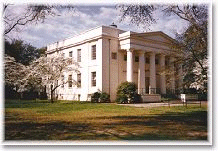

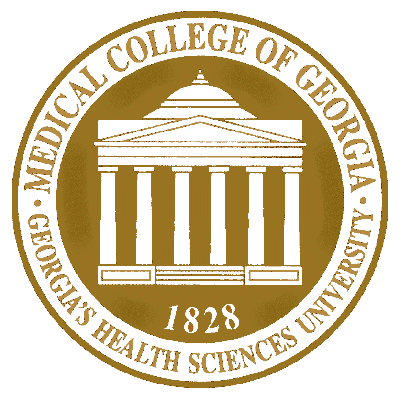
Copyright 2001, FineArtWest This constitutes a private offering of a rare and historic collection. Additional information about each item is available on this web page.
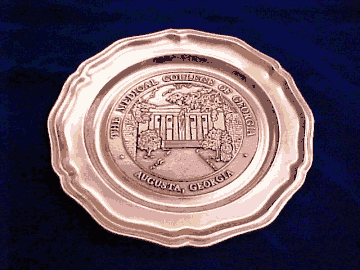
No. 1 - Pewter Plate Featuring Old MCG Building
No. of plates in collection: 3
Condition of the plates: 3 excellent
Dimensions of item: 10 1/2" across
Approximate date of item: 1976
Price of each collection item: $500
How to Order
Return
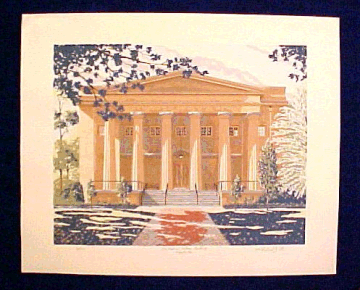
No. 2 - Silk-Screened Print of Old MCG Building in Augusta
by Richard J. Ellis
No. of prints in collection: 2
Prints numbered as: 20/93 (1981), and 22/93 (1981)
Print only area: 15" height, 19" width
Overall size of paper: 19 1/2" height, 24" width
Number of screens/colors: 18
Condition of the plates: 2 excellent, suitable for framing
Best shipping method: Hand delivery, or secure mailing tube.
Date of item, marked on each print: 1981
Price of each collection item: $2,000
How to Order
Return
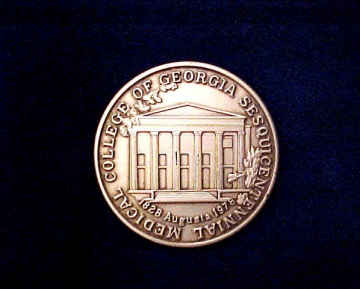
No. 3 - Pure Silver MCG Coin/Medallion
No. of items in collection: 3
Condition of the medallions: 3 excellent
Dimensions of item: 1 1/2" across
Approximate date of item: 1978
Price of each collection item: $300
How to Order
Return
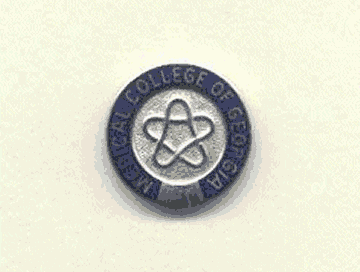
No. 4 - MCG Lapel Pin, Infinity Logo, Numbered 5
No. of pins in collection: 1
Condition of the pin: 1 excellent
Approximate date of item: 1976
Dimensions of item: 1/2" across
Price of each collection item: $25
How to Order
Return
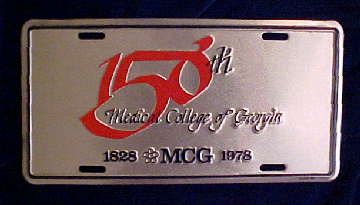
No. 5 - MCG 150th Year License Plate
No. of plates in collection: 3
Condition of the plates: 3 excellent
Approximate date of item: 1978
Price of each collection item: $150
How to Order
Return
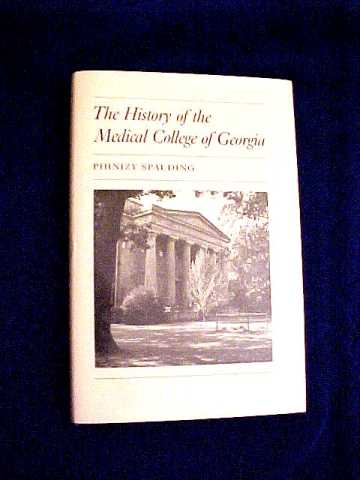
No. 6 - Official MCG History
Authored by Dr. Phinizy Spaulding
Professor of History at the University of Georgia
No. of books in collection: 1
Condition of the book: excellent
Date book was published: 1987
Number of pages: 290
Years covered in this history: 1828 to the 1980s
Letter signed by Dr. Spaulding included.
Price of each collection item: $250
How to Order
Return
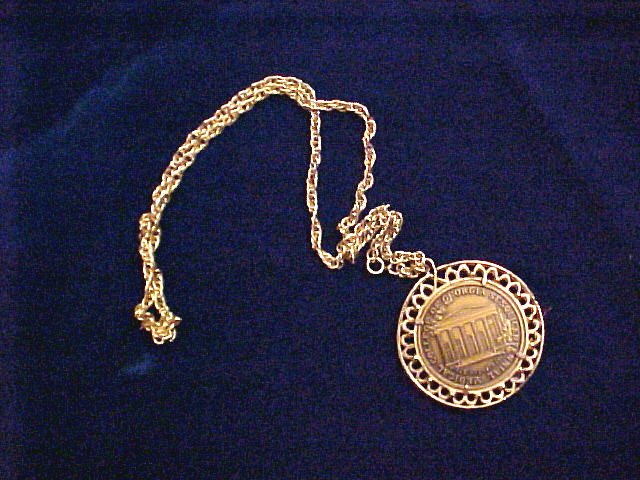
No. 7 - MCG Sesquicentennial Pendant
No. of pendants in collection: 4
Condition of the pendants: 4 excellent
Dimensions of item: 2 1/2" across
Approximate date of item: 1978
Price of each collection item: $100
How to Order
Return
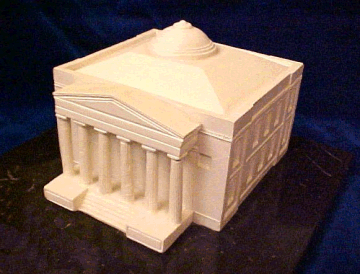
No. 8 - Sculpture of Old MCG Building
by Freeman Schoolcraft, noted Chicago sculptor
who retired and worked in Augusta, Georgia
No. of sculptures in collection: 1
Condition of the cast sculpture: excellent
Dimensions of the cast replica: 6" width, 7" depth, 4 1/2" height
Dimensions of the base: 10 1/2" width, 13" depth, 3/4" thick
Materials involved: Base, black marble; replica, hardened plaster.
Approximate date of item: 1984
Price of each collection item: $2,750
Shipping: Hand delivery in the US only, included in price.
How to Order
Return
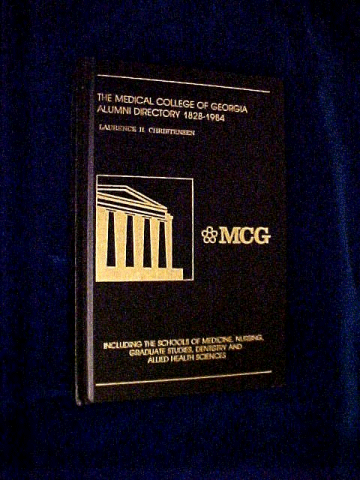
No. 9 - MCG Alumni Directory 1828-1984
No. of books in collection: 2
Condition of the books: Both with bookplates
Approximate date of item: 1984
Size of book: 374 pages
Contents: Names of all MCG graduates since 1828,
7-page history, includes schools of Medicine, Nursing,
Graduate Studies & Allied Health Sciences
Price of each collection item: $200
How to Order
Return
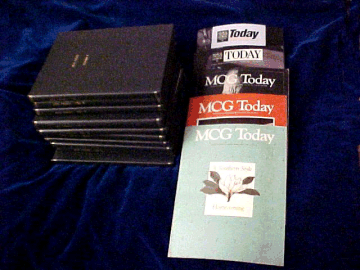
No. 10 - Rare Volumes of MCG Today Alumni Magazine
No. of volumes in collection: 12 complete, Volumes 1 - 10 bound
Additional unbound issues: Vol 11 - complete; Vol 12 - 3 of 4; Vol 13 - complete; Vol 14 - 1 of 4; Vol 15 - none; Vol 16 - 2 of 4; Vol 17 - 1 of 4; Vol 18 - none; Vol 19 - 2 of 4; Vol 20 - 1 of 4.
Condition of the publications: excellent
Type of binding for bound volumes: blue library binding
Approximate dates of publications: Vol 1 - 1970-1971, etc.
Price of complete collection: $2,000
How to Order
Return
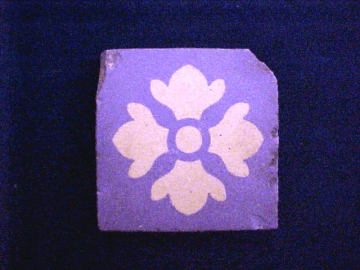
No. 11 - Tile Salvaged from MCG Newton Building
No. of tiles in collection: 1
Condition of the tile: imperfect, as shown
Approximate date of item: Newton building, a former orphanage, was purchased, renovated and placed into service in January 1913. The building was still standing in 1958, but was torn down several years later.
Dimensions of item: 2" x 2" x 1/2"
Price of each collection item: $100
How to Order
Return
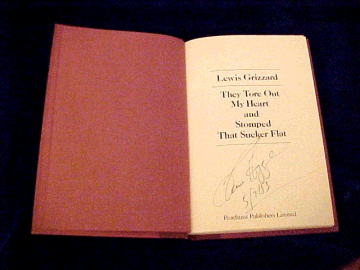
No. 12 - "They Tore Out My Heart and Stomped That Sucker Flat"
by the late Georgia humorist, Lewis Grizzard
Autographed just prior to speaking to standing-room-only crowd at MCG Homecoming on May 7, 1983. Subject of speech: His experience as a cardiology patient.
No. of books in collection: 1
Condition of the book: dust jacket tattered, but book excellent
Date of publication: 1982
Price of each collection item: $250
How to Order
Return
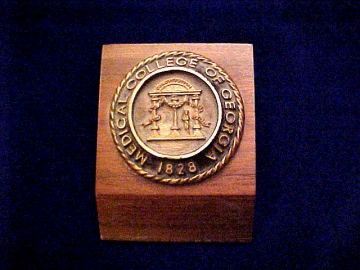
No. 13 - Heavy Bronze Casting of MCG Seal
No. of seals in collection: 1
Condition of the seal: excellent
Condition of the base: walnut wood in good condition
Dimensions of seal: 3" across, 5/8" thick
Approximate date of item: 1970
Price of each collection item: $150
How to Order
Return
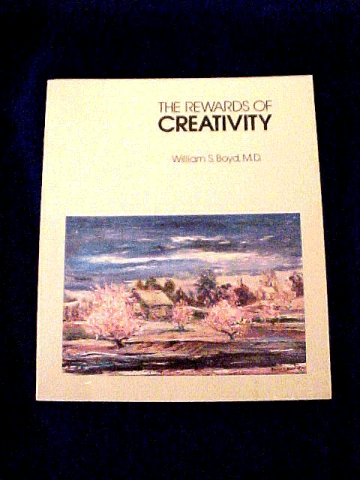
No. 14 - "The Rewards of Creativity"
by MCG Alumnus William S. Boyd, M.D., Autographed
No. of books in collection: 1
Condition of the book: minor marks on cover, otherwise excellent
Date of publication: 1983
Contents: 62 works of art, 46 in full color
Price of each collection item: $250
How to Order
Return

No. 15 - "Run With The Horseman"
by MCG Alumnus Ferrol Sams, M.D., of Fayetteville, Georgia
Novel, Autographed by the Author
No. of books in collection: 1
Condition of the book: excellent
Date of publication: 1982
Price of each collection item: $150
How to Order
Return
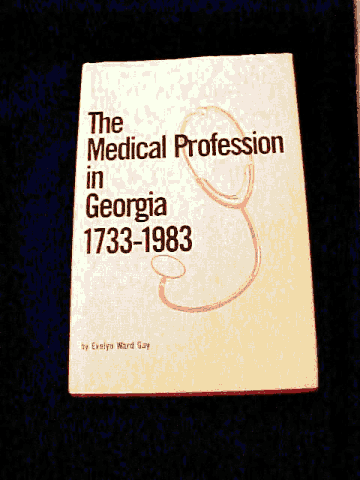
No. 16 - "The Medical Profession in Georgia, 1733--1983"
by Evelyn Ward Gay
No. of books in collection: 1
Condition of the book: excellent
Date of publication: 1983
Price of each collection item: $100
How to Order
Return

No. 17 - "If I Ever Get Back to Georgia
I'm Gonna Nail My Feet to the Ground"
by Lewis Grizzard
No. of books in collection: 1
Condition of the book: excellent
Date of publication: 1990
Relationship to MCG: None whatsoever, but makes a nice companion volume to "They Tore Out My Heart and Stomped that Sucker Flat."
Price of each collection item: $30
How to Order
Return
This website is that of a private collector
and is not an official or approved site of
the Medical College of Georgia, Augusta, Georgia
The Infinity Logo of MCG The logo used by the Medical College of Georgia during its sesquicentennial period was designed as a variation of the universal infinity symbol. It represents the battle to save and enhance life that is constantly being waged by all of the health professions. It also resembles a flower blossom, another symbol of the promise of healthy life. The intricate intertwining flower includes five "petals." Each represents one of the five schools of MCG: Medicine, Dentistry, Nursing, Graduate Studies, and Allied Health Sciences.

Brief History of MCG 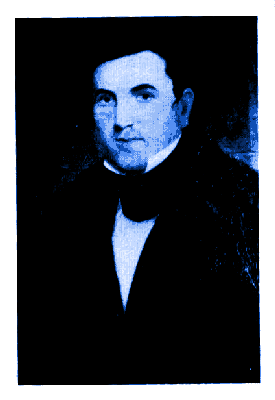
Dr. Milton Antony, 1789-1839
Chief Founder, Medical College of Georgia
In the early 1800's, most physicians in America had no formal degrees. Instead, they trained as apprentices for a few years to learn their trade. There were fewer than 100 physicians in Georgia. As the number of medical schools in the U.S. increased, so did the number of Georgia physicians with degrees.
In 1822, several Augusta area physicians organized the Medical Society of Augusta. They apparently hoped to start a school in Augusta, but no formal plans were drawn up by this group.
In 1826 Dr. Milton Antony, a leader in local medical circles, began to teach apprentices in two borrowed rooms of the City Hospital (opened in 1818). Dr. Antony had trained under the preceptor system, attending only one formal course of lectures at the University of Pennsylvania. He was unable to return for the second required term because of finances and so did not receive his degree. After about fifteen years of active practice in Georgia and Louisiana, he received his M.D. "ad eundum" in 1825 from the Medical College of South Carolina.
With strong local backing, Dr. Antony journeyed to Milledgeville, then the state capital, seeking a charter. The Medical Academy of Georgia was chartered by the State in an act that was signed into law on December 20, 1828, by then-Governor John Forsyth of Augusta.
The first class at the Academy began on October 1, 1829, in rooms of the City Hospital that had been renovated and equipped by the faculty at a cost of $457.13. There were seven students at that first session.
On December 19, 1829, the General Assembly authorized the school to grant the M.D. degree and changed the name to the Medical Institute of Georgia. The first formal commencement was held on April 7, 1833, with four graduates. It was also in 1833 that the school received its present name, the Medical College of Georgia. It was with this name that the first diplomas were engraved and awarded.
In 1834 construction of the stately Medical College building on Telfair Street was begun. The legislature, pleased with the progress of the school in Augusta, appropriated $10,000, along with 50 lots on the town common of Augusta to be sold, the proceeds to be paid over to the College. The city gave $5,000, in return for medical care for the city's prisoners and the poor at City Hospital. The remarkable domed building was occupied in 1835, completed in 1836, and served as the main teaching facility for the school until the end of 1912.
In January of 1913, the school moved to larger quarters in the Newton Building some distance away. The original Medical College of Georgia building, still standing today, has come to symbolize the entire institution.
The school grew and by the 1850s classes were large and well-attended--right up until December 20, 1860, when South Carolina seceded from the Union. Georgia took the same course on January 19, 1861. During the war the school was closed, and the Medical College building itself was converted into a military hospital.
MCG next held classes on November 6, 1865, with 47 students attending, including 3 Yankee soldiers. The first post-war commencement was held on February 24, 1866, with 9 students receiving degrees. It is a tribute to the strength and fortitude of the faculty of the College that they were able to reopen at all in the misery and deprivation of the post-war South.
On July 5, 1873, following negotiations, a loose agreement was struck between the Medical College of Georgia and the University of Georgia in Athens. From 1873 to 1950 the school was called "The Medical College of Georgia, being the Medical Department of the University of Georgia."
The first extant record of alumni organization was in 1891, when 15 alumni met to formally elect officers.
MCG received a "class A" rating in 1907, but medical education was generally in a sorry state in the early 1900s. In 1910 Abraham Flexner published a scathing report that struck death blows to many proprietary medical schools. He recommend the immediate closing of the Medical College of Georgia. The faculty and the legislature acted quickly to bring MCG up to national standards. Unfortunately, the following 20 years saw a steady decline in the quality of operation of the Medical Department.
In 1931 the dean resigned and many faculty followed. The Depression and Politics were in charge, not the educators. In 1833 the Board of Regents voted to close the Medical College. A storm of support failed to move the legislature until Mr. Roy V. Harris, Augusta legislator and long-time Speaker of the House of Representatives, managed to convince Governor Eugene Talmadge to change his vote on the Board of Regents. The other Regents soon saw the light and the school survived.
Nevertheless, in 1934 the AMA dropped the school from its "class A" list. In 1934 Dr. G. Lombard Kelly was named Dean and a massive program was undertaken to revitalize the College. Under his wise and vibrant leadership and with a strong base of support, the school returned to "class A" status in 1936.
World War II increased the demand for physicians, and brought a number of non-Georgians to Augusta. In 1945 the legislature authorized the construction of a badly needed new teaching hospital. Recognizing the difficulties involved in running a growing medical institution and a major hospital from Athens, leaders granted independent university status within the University System of Georgia in 1950. The traditional name, Medical College of Georgia, was restored to the 122-year-old school. Dr. Kelly was named the first President of MCG.
The new teaching hospital, Eugene Talmadge Memorial Hospital, opened in 1956, again in large part due to the efforts of Roy Harris in the General Assembly.
The early 1950s marked the emergence of MCG as a health sciences university. The nursing program begin in 1894 had evolved into a local hospital nursing school. In 1956 it merged with a nursing program at the University of Georgia, and became the School of Nursing. The medical technology program, in operation since 1937, became a baccalaureate program in 1955. A medical illustration program initiated in 1949 awarded its first M.S. degree in 1951.
Radiologic technology and medical record administration programs were established in 1962. Ph.D. programs were begun in 1963, which led to the establishment of a School of Graduate Studies in 1966. A School of Dentistry was approved in 1965, accepted its first students in 1969, and graduated its first DMDs in 1973.
An associated dental sciences program was started in 1967. The School of Allied Health Sciences combined this program with other disciplines in 1968, and grew to include nine major disciplines. A master of science in nursing program was started in 1968. Programs in physical therapy, occupational therapy, and respiratory therapy followed. A master of health education in many of these disciplines was approved in 1974.
The physical plant grew to include dozens of state-of-the-art facilities. It is difficult to believe that the very existence of this medical university was threatened so many times during its first 150 years. Despite its on-again off-again administrative relationship with the University of Georgia, a steady stream of UGA students have passed through MCG, creating a dual alumni loyalty that remains strong and unbreakable today.
At the Medical College of Georgia in Augusta, it is still true that most medical students are graduates of the University of Georgia. As physicians, there is a strong tradition of going into general practice or family practice in Georgia, or returning to Georgia after residency training elsewhere.
In the MCG alumni records of those who are now deceased, one of the most common entries is: "Died while attending University of Georgia football game." This is truly how most of these UGA/MCG alumni would prefer to leave this world.
Before fax and email, students penned more letters home to their families, girlfriends and boyfriends, and past acquaintances than they do now. A box of stationery was an essential item for every student. And of course, to demonstrate their growing loyalty, many purchased specially designed college stationery at the college bookstore or in town.
Over the years the symbols on University of Georgia student stationery changed as graphic artists and stationers did their best to attract young student buyers. That tradition persists, but pen and ink letter writing has become a lost art.
Most student letters from the 1930s, 1940s and 1950s have sooner or later been discarded, and with them generations of beautiful UGA logos and designs were lost. But not necessary forever.
At the Medical College of Georgia decades of student letters requesting information, applications, clarifications, appointments, deferrals, and other such requests were routinely dropped into student files. These files were stored in boxes, until administrators felt comfortable about discarding them.
In the 1980's, work-study students from nearby schools were asked to participate in this process, carefully looking through each MCG student file from the 1930s to the 1950s for anything of lasting importance that should be saved.
All sealed envelopes marked "Confidential" were sent to administrators for final disposition, and all else was to be discarded. However, the designs on the stationery of prospective students were so eye-catching that the work-study assistants could not bring themselves to discard them. A box was designated as a repository, but soon it too was set aside for ultimate disposal.
At that point, the letters with their unique letterhead designs were saved from destruction by Larry Christensen, who was leaving Augusta to move to the West. Over the years the historical significance of this collection has grown, as other repositories of UGA student letters have been destroyed as part of the march of time.
Today this rare collection contains 32 striking UGA letterheads. In 12 cases, the only known speciman in that style is preserved in this collection. In another 8 cases, only two known specimans of a specific style exist, and both are held in this collection. As a result, there is only one full collection that includes all 32 stationery styles. This truly is a unique and rare collection of colorful University of Georgia / Medical College of Georiga history.
The collection was never meant to be placed on the market, but in recognition of the need to stabilize the acid-based papers on which most of these designs were printed, Mr. Christensen has decided to offer the collection for sale. At the same time, he wishes to help students today at both the University of Georgia and at the Medical College of Georgia (see Terms and Conditions).
In a race against time, this collection will be preserved by a private collector, or by one of Georgia's institutions of higher education or government. Interested parties are urged to contact the private owner in San Diego. No copies of any documents will be sold until the one complete collection has been sold, in order to preserve the collection in its entirety. When that happens, the remaining documents will be available for sale individually.
This collection is available for purchase on an item by item basis. Most items can be shipped, but Item No. 8, the sculpture of the Old Medical College Building, will be hand-delivered within the U.S. in order to guarantee safe arrival. The cost of delivery is included in the price. Items are available for personal inspection in San Diego prior to purchase. Arrangements for inspection and delivery can be made by contacting the private owner directly.

